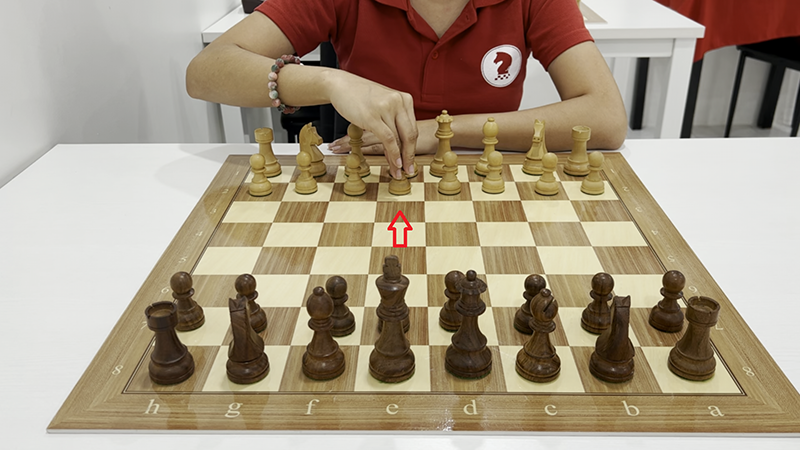- Red Knight Chess-
- April 10,2022
Probably the most important rule that your child should know before signing up for the very first chess tournament, is the touch-move rule. It simply means that in chess, one must move the first piece that he/she has touched. For us adults, there is nothing more easier in chess than following this simple rule. However, children can be too excited about their games in the beginning, and it takes some time and a tournament experience for them to achieve this.

On the photo, the player with the white pieces touched the pawn on e2. She then must move that pawn. She is not allowed to change her mind and play with a different pawn or a piece.
Nowadays, children play and learn chess online, and while doing so, they can touch the pieces on the screen as many times as they want. There is no touch-move rule in the online chess world. You can pick up the piece, drag it to the desired square, then change your mind. You can move it back and pick up another one. This will make harder for a child who rarely plays chess over-the-board, to get use to the rule.
Rules are rules and they apply regardless if we are familiar with them or not. Not knowing the rules might lead to making irregular moves and forfeiting the game. In this article, I would like to explain the most important situations that might occur. If you are a chess parent or a chess coach, please try to help your child or your student to understand these situations.
Is any touch of a piece considered to be a touch-move?
If a player touches a piece with the intention of moving it, he is obliged to move it. This means that an accidental contact with the back of the hand with the piece will not trigger the rule. However, touching the piece with a finger or grabbing the piece with the front side of the hand, will.
What happens if my opponent touched more than one piece?
If a player touched more than one piece, he shall move the first piece that he touched.
Is touching one of my opponent’s pieces considered to be a touch move?
If any of your pieces can capture that piece then yes, it is a touch move.
I touched a piece, but I cannot move it because I realized that my King will be in check.
In this case, the touch move rule will not apply because you do not have any legal moves with it. You can play with another piece or a pawn.
My Queen is misplaced. I want to adjust it because it bothers me, but touching it would mean that I will have to move it, and I don’t want to do that.
Before touching the Queen, say “I adjust”. Say it clearly, so that that your opponent can hear you and there are no misunderstandings about your intention. Remember that saying “I adjust” or “I was adjusting” after you touched the Queen, will be too late.
My opponent touched his Rook. Then he let go of the Rook and now he is thinking. Should I tell him that he did a touch move, or maybe call the arbiter?
Neither. Your opponent touched his Rook and the touch-move rule will apply. But he is allowed to let go and think where to move it. You are not allowed to interrupt his thinking, and you shouldn’t call the arbiter because the move has not been done yet. Your opponent will most likely move the Rook after some thinking. If he does not, then you can certainly call the arbiter and explain the situation. You can read more about this in the Irregular moves article.
My opponent touched his Rook, moved it from a1 to d1, and back to the a1-square. Now he is thinking again. Is this allowed?
If your opponent did not released the Rook from his hand, then it is okay. He can think and decide where to move his Rook, but he must move it. If he moves another piece, then you can raise your hand and wait for the arbiter to come.
My opponent touched my Knight with his Bishop, but then went back with his Bishop and now he is thinking.
Your opponent must capture your Knight with his Bishop, if that was a legal move. But you should not interrupt him. Instead, wait patiently until he makes his move.
In the examples above we covered the most common touch-move situations that are occurring in school tournaments. I hope that this article will help you to understand these situations better. As always, it takes some time and experience for young players to understand the rules, but playing chess competitions will certainly help.
